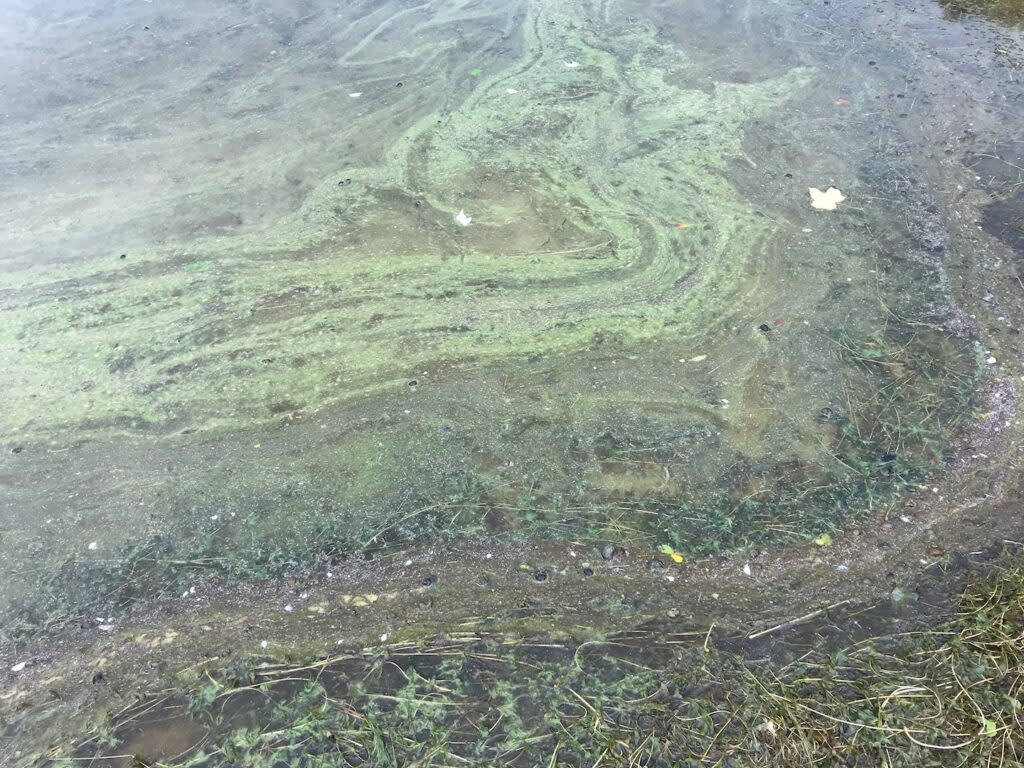Cyanobacteria blooms can produce dangerous toxins. Here’s what to know.

Toxins in the blooms are harmful to people and animals. (N.H. Department of Environmental Services, des.nh.gov.)
The Granite State hasn’t been spared from the global trend of more frequent cyanobacteria blooms, the often-toxic growths that can kill pets and threaten human health.
With climate change and excess nutrients getting into water bodies, “we can expect more and more cyanobacteria blooms every year,” said Kate Hastings, the cyanobacteria harmful algal bloom program manager for the Department of Environmental Services.
If you see blooms, “it’s safe to assume they’re producing some toxins,” said James Haney, a University of New Hampshire biological sciences professor who has for years studied cyanobacteria.
“If you’re preparing to go camping out in the West, you learn about grizzly bears,” Haney said. “If you’re preparing to recreate on the waters in the Northeast, in New Hampshire, or practically anywhere nowadays, you have to familiarize yourselves with what these cyanobacteria look like.”
Cyanobacteria resources
Climate change is exacerbating the blooms in a few ways. Rising temperatures mean longer growing seasons and less ice cover, creating a larger stretch of time each year suitable for cyanobacteria growth, Hastings said.
Surface waters are also warming, she said, which can stratify lakes – making them form separate thermal layers – and starve the lake bottoms of oxygen.
“That condition allows phosphorus that’s previously been bound to sediments to release into the water column into a form that the cyanobacteria are able to use to fuel their growth,” Hastings said.
In 2023, the DES recorded its most blooms ever, affecting 47 lakes. But the record numbers are also a sign of greater awareness.
“The more informed the general public is, the more reports we get, which is great, because we want to communicate about it,” Hastings said, “but it makes it hard to use our data set to understand if cyanobacteria are actually increasing in New Hampshire or if we’re just getting better at tracking it.”
The blooms can produce toxins that can kill pets and cause a variety of health problems in humans: rashes, fevers, headaches, mouth blisters, vomiting, acute liver damage, and more, according to the DES.
They can also produce neurotoxins that “cause tingling, numbness, and, in severe cases, seizures,” Hastings said.
The acute, short-term safety risks of exposure to cyanotoxins are better understood than the impact of long-term exposure, a gap that Haney and his researchers are trying to bridge.
The primary root of exposure is ingestion, Hastings said, which can happen while swimming in affected waters. Pets are more likely to drink lake water, and children are more likely to swallow water while swimming, putting them more at risk. Aerosol exposure can also pose risks.
“I’ve observed people kayaking through cyanobacteria blooms on the surface and just assuming that it wasn’t harmful,” Haney said. “It can have great harm.”
The department relies on residents reporting potential blooms, which can take on a variety of colors – blue, green, yellow, white, brown – and appearances – scum, blotches, spilled paint. If you think you’ve spotted a bloom, you can report it to the department through an online form.
Residents can check Healthy Swimming Mapper, a tool created by DES, for up-to-date information on reported blooms. They can also sign up for email alerts about individual water bodies and statewide updates.
Alerts should be treated “as statements to be on the watch for a potential cyanobacteria bloom,” according to the DES. Warnings mean that cyanobacteria have been found at a concentration where harmful toxins could be present and threaten public health. The department advises residents to avoid water bodies under warnings.
Residents should note, though, that just because a water body doesn’t have an alert issued doesn’t mean it’s necessarily clear. “When in doubt, stay out,” the department advises.
For property-owners interested in assessing general lake health, LakeSmart is a free, voluntary resource. Residents can fill out a form to receive an individualized report of suggestions. After they make updates, they can submit photos or receive a visit from an evaluator for further advice.
The post Cyanobacteria blooms can produce dangerous toxins. Here’s what to know. appeared first on New Hampshire Bulletin.

